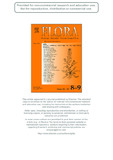Vegetative and reproductive phenological traits of Rhizophora mucronata Lamk. and Sonneratia alba Sm

View/
Date
2013Author
Wang’ondu, Virginia W
Kairo, James G
Kinyamario, Jenesio I
Mwaura, Francis B
Bosire, Jared O
Dahdouh-Guebas, Farid
Koedam, Nico
Language
enMetadata
Show full item recordAbstract
Mangrove phenology is important in understanding the past, present and future response of mangrove
species to impacts of climate change. Our study is the first long term direct observation of the phenology
of Rhizophora mucronata and Sonneratia alba in Kenya. Objective of the study was to determine, interpret
and document the timing of the various phenoevents and phenophases, and to establish relationships
between phenology and the climatic variables. Phenological traits were investigated in six monospecific
mangrove stands in Gazi Bay, south of Mombasa, for 2 years. Leaf emergence, leaf fall, flower bud, flower
and fruit initiation data were recorded every fortnight in 54 shoots of 9 trees at each site. Continuous leaf
emergence and loss characterized by multimodal peaks was observed for the two species. Leaf emergence
and leaf fall peaked in the wet months and was reduced in the dry months. There was a relationship
between the leaf emergence and drop with the reproductive phenology in the two species. Mean leaf
longevity for R. mucronata and S. alba was 12.8
± 1.2 and 4.9 ± 0.5 months respectively. The reproductive
cycle took approximately 16–20 months in R. mucronata and 4–5 months in S. alba. Bud initiation in R.
mucronata was seasonal and occurred in October and September. Buds were observed for 8–11 months
developing slowly on the shoots. Shifts were observed in the timing of flower initiation, and the flowering
period lasted in total for 4–5 months. The time period from flower appearance to the developmental start
of immature propagules lasted about 1 month at reforested sites and up to 5 months in stands of natural
vegetation. In R. mucronata initiation of immature propagules was not seasonal and varied among the
sites. Fruiting in S. alba was short and seasonal without overlap, and shifts were observed in the timing
of flowering, flowering and fruiting peaks. Abscission of reproductive parts started in July and in June,
respectively, in the years 2005 and 2006. Fruiting was observed starting in August in both years, and
fruiting peak was reached in October in 2005 and one month earlier in 2006. In R. mucronata vegetative
and reproductive phenophases significantly correlated with climatic variables, whereas in S. alba only
leaf emergence and leaf fall correlated with temperature. The flowering plasticity in the reproductive
phenology of the two species indicates possible sensitivity to certain climatic and environmental triggers.
Our results also indicate that R. mucronata trees have a distinctly higher investment in the reproductive
cycle than S. alba.
Citation
Flora 208 (2013) 522– 531Publisher
University of Nairobi
Description
Journal article
